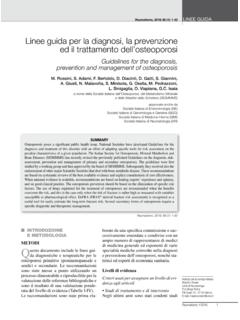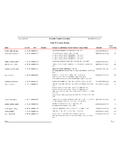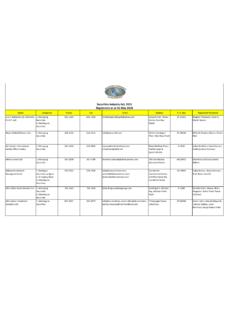Transcription of T.77e Management of Milk Replacer Mixing
1 2009 milk Products, LLC Management of milk Replacer Mixing There is an abundance of areas that require intense Management in order to raise healthy calves, such as nutrition, housing, and calf health. One area that sometimes gets overlooked is Management of milk Replacer Mixing , where errors and/or inconsistency may lead to digestive upsets such as nutritional scours and abomasal bloat. The goal of this article is to shed light on some common errors that take place on-farm, and suggest means of preventing such errors. Achieving Desired Solids Percentage The terminology used when describing milk Replacer Mixing rates can often be confusing. For example, calf feeders may refer to the amount of powder in 2 quarts of solution (ex. 8 oz, 10 oz, or 12 oz per 2 quarts), the amount of powder mixed in 1 gallon of solution (ex.)
2 , , or lbs per gallon), or perhaps the solids percentage (as-fed basis) of the final solution (ex. 12, 15, or 18% solids). Regardless of how it is described, it is important to assess whether the desired feeding rate is actually being met. milk Replacer Mixing directions on feed tags will often have directions for Mixing for an individual calf (ex. fill enclosed cup to 10 oz. line and add to 2 quarts of warm water), or for larger batches [ex. add 10 full cups ( lbs) to 5 gallons of warm water]. The key point to remember when Mixing large batches is that the powder needs to be added to the warm water BEFORE the final volume is reached. If the powder is added AFTER the pail contains 5 gallons of water, the final mix will be more dilute than desired and you ll end up with more solution than you need. Here is an example with calculations of total solids and the differences that can occur if mixed incorrectly: Example feeding program: 20-20 all- milk milk Replacer .
3 Each calf should receive lbs of milk Replacer powder (as-fed) daily in a volume of 1 gallon of total solution (2 quarts fed twice daily), as-fed solids percentage equal to 15%, Mixing 5 gallons/feeding to feed 10 calves Approach #1: 5 gallons of warm water are added to a pail, followed by addition of lbs of powder Weight of water (5 gal lbs/gal = lbs) + powder (10-10 oz cups = 100 oz = lbs) = lbs Solids percentage (weight of powder/weight of total solution) = = Amount of powder fed to a calf if fed 1 gallon per day = lbs = lbs powder Approach #2: lbs of powder are added while filling a pail to 5 gallons of final volume Weight of final solution (5 gal lbs/gal) = lbs ( lbs powder included in final solution weight) Solids percentage (weight of powder/weight of final solution) = = Amount of powder fed to a calf if fed 1 gallon per day = lbs = lbs TAKE-HOME MESSAGE: Add powder BEFORE the final volume is reached; for example, fill a 5-gallon pail to 3 gallon mark with warm water, add powder, and bring volume to 5 gallons with warm water.
4 Adding the Correct Amount of milk Replacer milk Replacer bags commonly contain cups with marks to indicate 8 oz, 10 oz, and/or 12 oz of powder. This practice uses a volumetric approach to estimate powder weight. While this approach has been used for many years, Mixing errors may arise. One person s interpretation of level-full may be different than others. The density of the powder in each cup, even if it is filled to the same mark, may differ over time due to compaction of the powder within the bag or container, possibly leading to variation in powder weight in each cup. In addition, density of milk Replacer will differ among manufacturers a 10 oz cup from one manufacturer may be a 12 oz cup for another manufacturer so it is important to use the cup that is provided with the particular milk Replacer .
5 Page 2 of 2 2009 milk Products, LLC An easy way to avoid cup-weight issues is to always weigh the milk Replacer powder. A hanging scale is relatively inexpensive (~$40), durable, and straightforward. You can have a dedicated powder pail to hang from the scale, set the scale to zero , weigh the desired amount of powder into the pail, then add the powder to the water (before final volume level is reached, of course!). There are several choices when selecting a hanging scale1, but be certain to pay attention to total weight capacity of the scale to be sure it meets the needs of the operation. Adding the Correct Amount of Water As described above, errors in weighing powder can lead to milk Replacer intake that is lower or higher than anticipated. Determining the correct amount of water to add is also essential for proper milk Replacer Mixing .
6 This is fairly straightforward when using a 5 gallon bucket or other relatively small containers where volume can be easily calibrated. Some good tips for calibrating liquid volume for common types of containers can be found in a recent Calving Ease article (web link can be found in References at the end of this article). Feeders that mix larger volumes of milk Replacer may be using large vessels such as a mechanical mixer or a bulk tank. No matter what size container, powder should be added prior to the final volume being met to avoid Mixing a solution that is too dilute. However, knowing how much total solution to end up with can be a challenge. A feeder may use the bulk tank s dipstick and calibration table to gauge liquid volume, and mechanical mixers may have marked graduations to reference.
7 An additional tool that may be used is a water meter2 that indicates how much water has been added to a vessel as it is metered out of a hose or pipe. The trick with a water meter is knowing how much water is required to reconstitute the desired amount of powder if the final solution level is not known. If the desired solids percentage and total volume required is known, one should be able to calculate how much water to add to create the correct final solution. Temperature at Mixing and Feeding The water temperature recommended on a milk Replacer tag is specific for that type of milk Replacer . Recommended Mixing temperatures will vary due to the manufacturing process used. For example, some milk replacers call for Mixing temperatures of ~150 F, whereas others recommend 110-120 F. It is critical to follow temperature recommendations listed on the tag of the milk Replacer being used to avoid Mixing issues.
8 The temperature of the milk Replacer solution at feeding also requires monitoring. A solution that is too hot may affect milk Replacer intake by the calf, and a solution that is too cold may predispose the calf to abomasal bloat due to alteration of the abomasal/intestinal environment. All calves should be presented with a milk / milk Replacer solution that is around their body temperature (~103 F). The calf can tolerate temperatures slightly warmer, but rapid cooling of the solution to a temperature 95 F or below is a risk to calf health is due to its association with abomasal bloat. Maintaining feeding temperature is obviously a challenge during cold winter weather, so adjusting Mixing temperature to the high end of the recommended range is advised. Mixing and Feeding Equipment Once you are convinced that Mixing errors are unlikely to happen and Mixing and feeding temperatures are correct and consistent, another area to be evaluated is the condition of feeding equipment.
9 Mixing (whisks, mechanical mixers, etc.) and feeding equipment (pails, bottles, nipples, etc.) should be cleaned, sanitized, and allowed to dry completely after every feeding. In addition, evaluate the condition of nipples and dispose of nipples that have cracked or where the nipple hole is worn. Worn nipples may lead to faster-than-desired milk / milk Replacer consumption another risk for bloat due to fast milk flow through the nipple. References Bertoldo, J. Sudden Bloat and Death in Calves. Cornell University Cooperative Extension. Available here: Fox, L. A Recipe for Bloat. Dairy Herd Management s Calf and Heifer Adviser, June 25, 2007. Available here: Leadley, S. Mixing milk Replacer . Calving Ease, January 2009. Available here: 1 Example of a hanging scale: (X)N 2 Example of a water meter.





